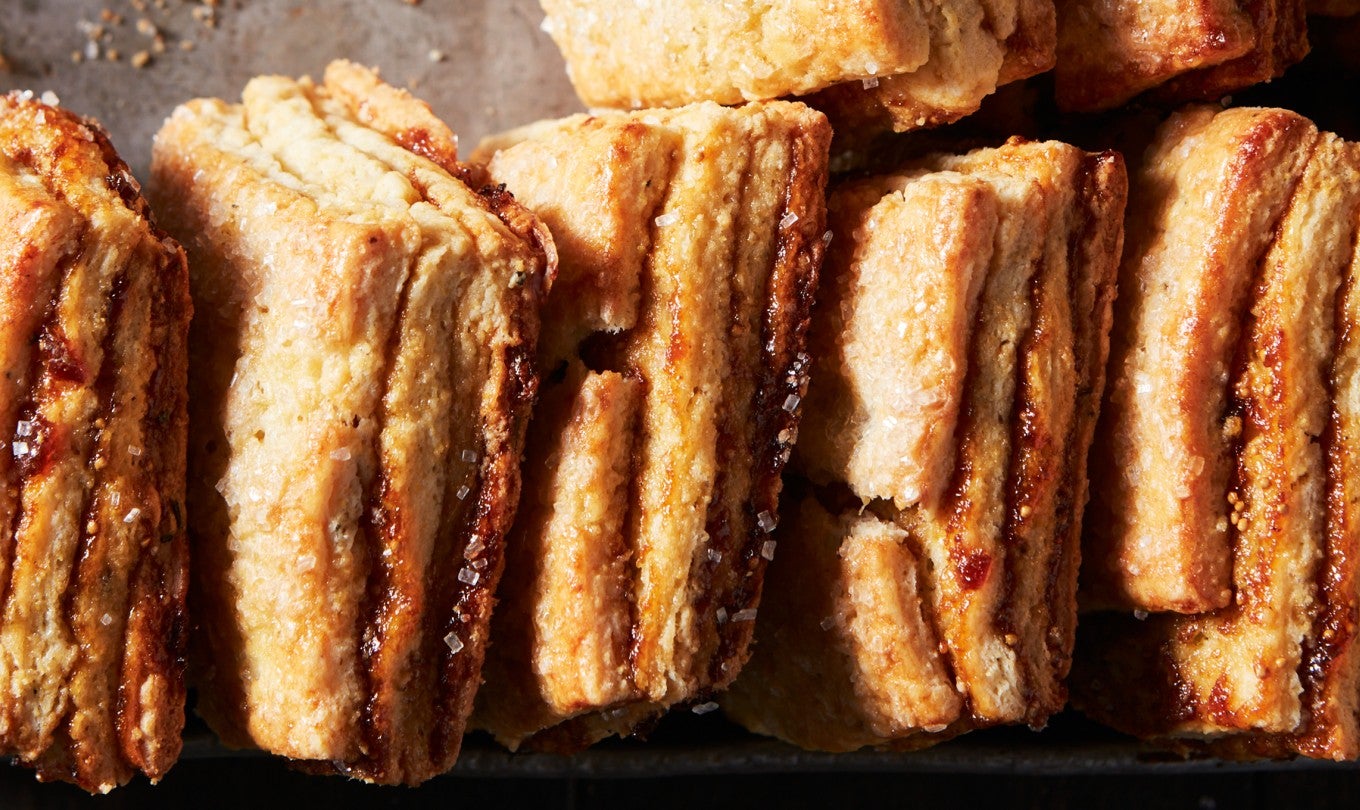-
Weigh your flour; or measure it by gently spooning it into a cup, then sweeping off any excess. In a large bowl, mix together the flour, cornmeal, sugar, baking powder, and salt.
-
Into the bowl, add the cubes of chilled butter and toss to coat them with flour. Use your fingers to pinch each cube flat. Once you’ve made it through all the cubes, begin smearing the flattened pieces into the flour with your fingertips until they begin to break apart and integrate into the flour. Continue this process until the mixture resembles wet sand with the occasional peanut-size piece of butter.
-
Add the rosemary to the bowl and toss to incorporate. (Choose how much rosemary you use depending on how much you love the flavor!)
-
In a bowl or large measuring cup, whisk together the eggs. Add the heavy cream and whisk until thoroughly combined.
-
Pour the heavy cream/egg mixture into the flour/butter mixture. Use your hands or a silicone spatula to gently mix until only a little bit of dry flour remains at the bottom of the bowl. Dump the contents of the bowl onto a piece of parchment.
-
Pat the mixture into a rough rectangle about 1" tall, gathering stray crumbles from the edges and adding them to the center. Use your hands or a bench knife to make neat, compact sides.
-
Use the bench knife or a sharp knife to divide the dough in half and stack one piece on top of the other. Pat down this stack until the dough is back to a rough 1" tall rectangle. Do this one more time, cutting the dough in half and stacking it on top of the other piece, focusing on squaring up the edges as you go. Flour your parchment if the dough starts to stick at any point.
-
Press down on the stacked layers of dough one more time until it is a 12" x 8" rectangle, about 1/2" thick. Fold the parchment over the dough to tightly wrap, then transfer to the refrigerator to chill for at least 1 hour and as long as overnight. (If the dough is refrigerated for longer than an hour, let it rest at room temperature for a few minutes to warm up before moving onto the next step.)
-
Remove the dough from the refrigerator and divide into four equal rectangles measuring 3" x 8". On a well-floured surface, roll out each rectangle until the final dimensions are 6" x 12" and about 1/4" thick. Stack the rectangles on a baking sheet and return to the refrigerator for at least 15 minutes to firm up.
-
Remove the chilled dough from the refrigerator, and starting with one piece, dollop 3 tablespoons fig jam over the entire surface of the rectangle (a scant muffin scoop works well here). Spread the jam evenly over the dough from edge to edge. You will have a very thin layer; only add more jam if necessary — less is more in this case.
-
Carefully stack and press a second rectangle of dough onto the first layer. Spread another 3 tablespoons of jam evenly over the top. Repeat this layering process until all four pieces of dough are stacked with jam between each layer. (There will be three layers of jam.) Be careful not to press down on the layers of dough while stacking them to avoid pushing the jam out between the layers.
-
With a sharp knife, cut the stacked dough in half the long way, and then cut each strip into four even pieces for a total of eight 3" x 3" scones.
-
Arrange the scones on a parchment-lined baking sheet with 2" to 3" of space between them. Cover with plastic and place into the freezer for at least two hours or, preferably, overnight.
-
Preheat the oven to 400°F with a rack in the upper third.
-
Remove the scones from the freezer and brush the tops with egg wash, then sprinkle with sparkling sugar.
-
Bake the scones for 10 minutes, then lower the oven temperature to 350°F. Bake for an additional 10 to 15 minutes, until the scones are firm to the touch and lightly golden. If any of the layers of dough have shifted during baking, you can use a lightly oiled spatula or butter knife to push them back into place. Let the scones cool on the baking sheet, during which time the layers will set. Serve slightly warm or at room temperature.
-
Storage information: Scones can be stored at room temperature in an airtight container for several days. To reheat, place scones in a 300°F oven for 6 to 10 minutes. Unbaked scones can be stored, well-wrapped, in the freezer for several months. Bake directly from frozen.






















